Immigrants from Burma/Myanmar vs European Community Comparison
COMPARE
Immigrants from Burma/Myanmar
European
Social Comparison
Social Comparison
Immigrants from Burma/Myanmar
Europeans
3,365
SOCIAL INDEX
31.2/ 100
SOCIAL RATING
222nd/ 347
SOCIAL RANK
8,117
SOCIAL INDEX
78.6/ 100
SOCIAL RATING
87th/ 347
SOCIAL RANK
European Integration in Immigrants from Burma/Myanmar Communities
The statistical analysis conducted on geographies consisting of 171,998,770 people shows no correlation between the proportion of Europeans within Immigrant from Burma/Myanmar communities in the United States with a correlation coefficient (R) of 0.027. On average, for every 1% (one percent) increase in Immigrants from Burma/Myanmar within a typical geography, there is an increase of 0.010% in Europeans. To illustrate, in a geography comprising of 100,000 individuals, a rise of 1,000 Immigrants from Burma/Myanmar corresponds to an increase of 9.5 Europeans.
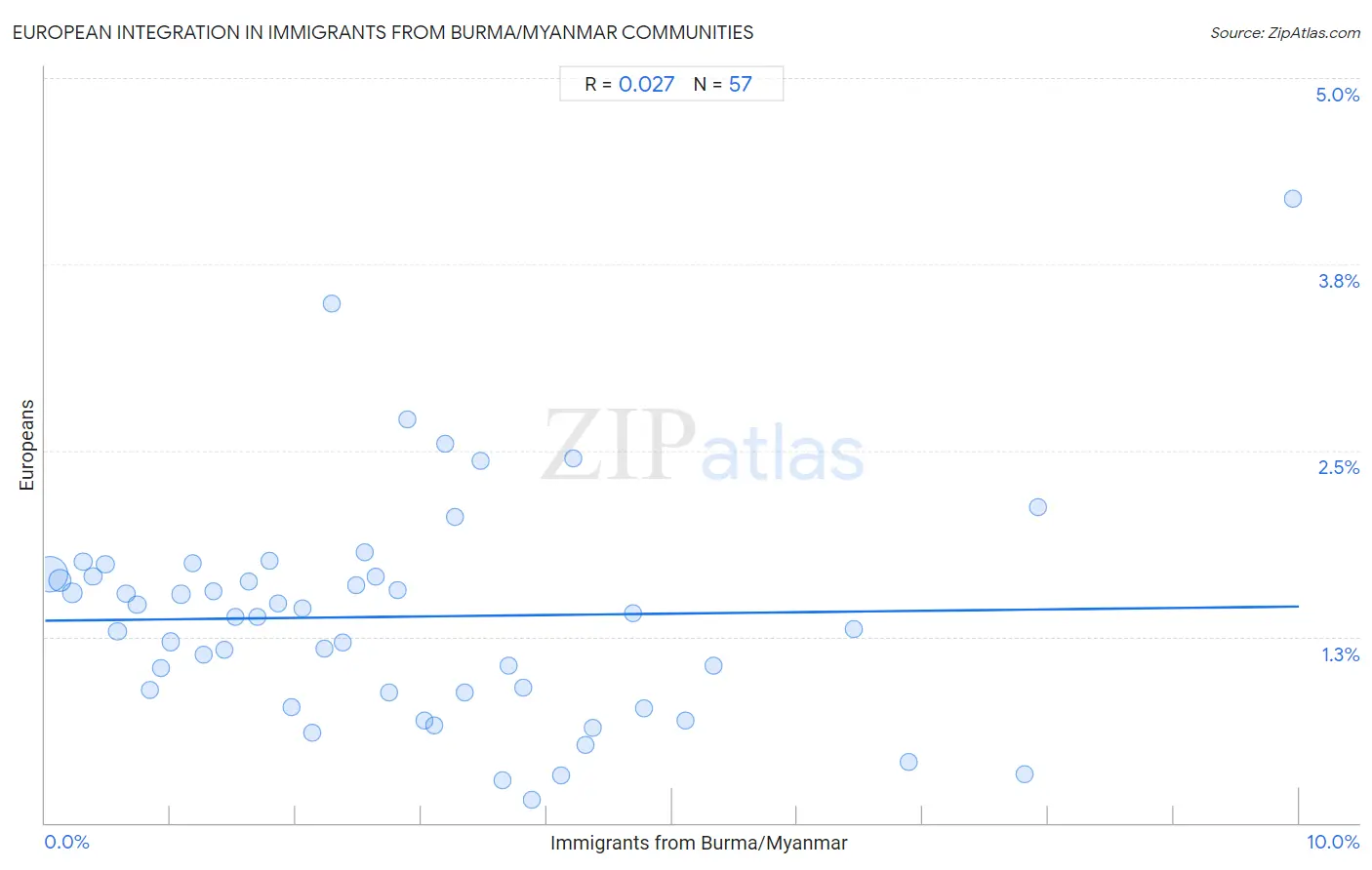
Immigrants from Burma/Myanmar vs European Income
When considering income, the most significant differences between Immigrants from Burma/Myanmar and European communities in the United States are seen in wage/income gap (22.8% compared to 29.4%, a difference of 28.6%), householder income ages 45 - 64 years ($91,385 compared to $106,367, a difference of 16.4%), and per capita income ($39,827 compared to $45,836, a difference of 15.1%). Conversely, both communities are more comparable in terms of median female earnings ($38,028 compared to $39,457, a difference of 3.8%), householder income under 25 years ($48,749 compared to $51,796, a difference of 6.2%), and median earnings ($43,998 compared to $47,915, a difference of 8.9%).

| Income Metric | Immigrants from Burma/Myanmar | European |
| Per Capita Income | Tragic $39,827 | Exceptional $45,836 |
| Median Family Income | Tragic $94,472 | Exceptional $108,099 |
| Median Household Income | Tragic $78,682 | Exceptional $88,751 |
| Median Earnings | Tragic $43,998 | Excellent $47,915 |
| Median Male Earnings | Tragic $50,298 | Exceptional $57,637 |
| Median Female Earnings | Tragic $38,028 | Fair $39,457 |
| Householder Age | Under 25 years | Tragic $48,749 | Fair $51,796 |
| Householder Age | 25 - 44 years | Tragic $86,736 | Excellent $98,310 |
| Householder Age | 45 - 64 years | Tragic $91,385 | Exceptional $106,367 |
| Householder Age | Over 65 years | Tragic $57,114 | Exceptional $63,779 |
| Wage/Income Gap | Exceptional 22.8% | Tragic 29.4% |
Immigrants from Burma/Myanmar vs European Poverty
When considering poverty, the most significant differences between Immigrants from Burma/Myanmar and European communities in the United States are seen in married-couple family poverty (6.0% compared to 4.2%, a difference of 42.6%), family poverty (10.5% compared to 7.7%, a difference of 36.2%), and receiving food stamps (12.9% compared to 9.5%, a difference of 35.6%). Conversely, both communities are more comparable in terms of single male poverty (13.1% compared to 13.3%, a difference of 1.0%), single father poverty (16.5% compared to 16.6%, a difference of 1.0%), and single mother poverty (30.6% compared to 29.1%, a difference of 5.2%).
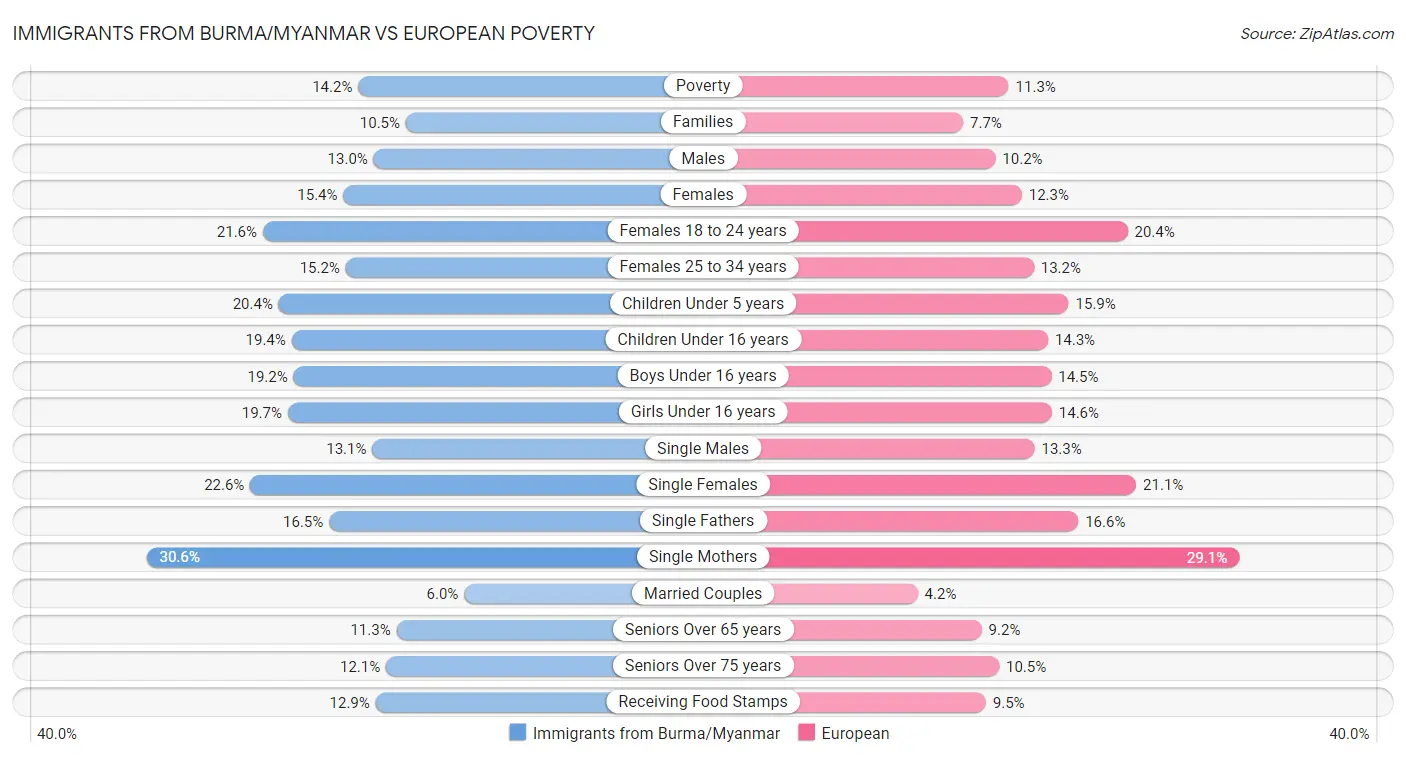
| Poverty Metric | Immigrants from Burma/Myanmar | European |
| Poverty | Tragic 14.2% | Exceptional 11.3% |
| Families | Tragic 10.5% | Exceptional 7.7% |
| Males | Tragic 13.0% | Exceptional 10.2% |
| Females | Tragic 15.4% | Exceptional 12.3% |
| Females 18 to 24 years | Tragic 21.6% | Poor 20.4% |
| Females 25 to 34 years | Tragic 15.2% | Good 13.2% |
| Children Under 5 years | Tragic 20.4% | Exceptional 15.9% |
| Children Under 16 years | Tragic 19.4% | Exceptional 14.3% |
| Boys Under 16 years | Tragic 19.2% | Exceptional 14.5% |
| Girls Under 16 years | Tragic 19.7% | Exceptional 14.6% |
| Single Males | Poor 13.1% | Tragic 13.3% |
| Single Females | Tragic 22.6% | Average 21.1% |
| Single Fathers | Fair 16.5% | Poor 16.6% |
| Single Mothers | Tragic 30.6% | Average 29.1% |
| Married Couples | Tragic 6.0% | Exceptional 4.2% |
| Seniors Over 65 years | Fair 11.3% | Exceptional 9.2% |
| Seniors Over 75 years | Good 12.1% | Exceptional 10.5% |
| Receiving Food Stamps | Tragic 12.9% | Exceptional 9.5% |
Immigrants from Burma/Myanmar vs European Unemployment
When considering unemployment, the most significant differences between Immigrants from Burma/Myanmar and European communities in the United States are seen in unemployment among seniors over 75 years (7.7% compared to 9.7%, a difference of 25.1%), unemployment among women with children ages 6 to 17 years (7.5% compared to 8.7%, a difference of 16.3%), and unemployment (5.1% compared to 4.6%, a difference of 10.0%). Conversely, both communities are more comparable in terms of unemployment among youth under 25 years (10.6% compared to 10.8%, a difference of 1.7%), unemployment among women with children under 6 years (7.3% compared to 7.5%, a difference of 1.9%), and unemployment among ages 55 to 59 years (4.4% compared to 4.5%, a difference of 2.1%).
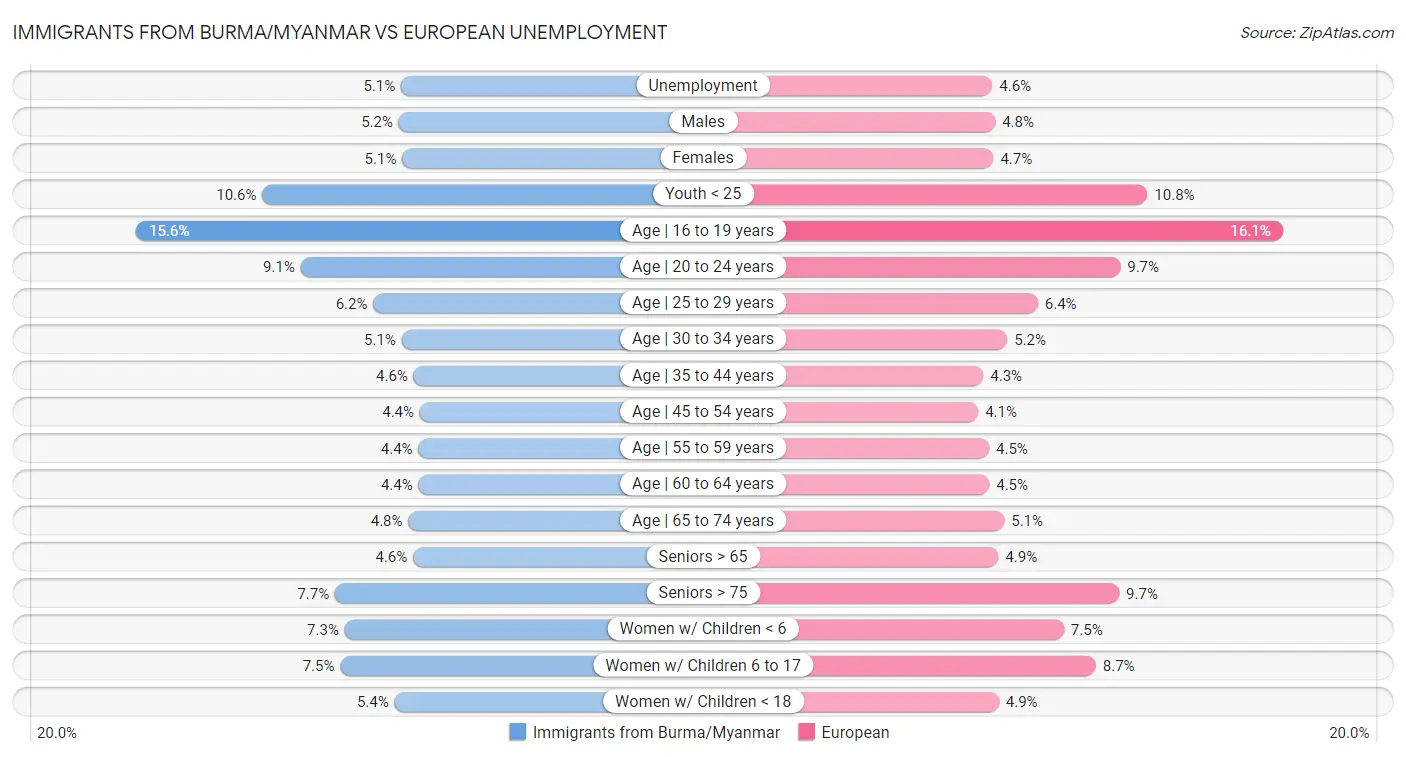
| Unemployment Metric | Immigrants from Burma/Myanmar | European |
| Unemployment | Excellent 5.1% | Exceptional 4.6% |
| Males | Good 5.2% | Exceptional 4.8% |
| Females | Exceptional 5.1% | Exceptional 4.7% |
| Youth < 25 | Exceptional 10.6% | Exceptional 10.8% |
| Age | 16 to 19 years | Exceptional 15.6% | Exceptional 16.1% |
| Age | 20 to 24 years | Exceptional 9.1% | Exceptional 9.7% |
| Age | 25 to 29 years | Exceptional 6.2% | Excellent 6.4% |
| Age | 30 to 34 years | Exceptional 5.1% | Exceptional 5.2% |
| Age | 35 to 44 years | Good 4.6% | Exceptional 4.3% |
| Age | 45 to 54 years | Exceptional 4.4% | Exceptional 4.1% |
| Age | 55 to 59 years | Exceptional 4.4% | Exceptional 4.5% |
| Age | 60 to 64 years | Exceptional 4.4% | Exceptional 4.5% |
| Age | 65 to 74 years | Exceptional 4.8% | Exceptional 5.1% |
| Seniors > 65 | Exceptional 4.6% | Exceptional 4.9% |
| Seniors > 75 | Exceptional 7.7% | Tragic 9.7% |
| Women w/ Children < 6 | Exceptional 7.3% | Good 7.5% |
| Women w/ Children 6 to 17 | Exceptional 7.5% | Exceptional 8.7% |
| Women w/ Children < 18 | Good 5.4% | Exceptional 4.9% |
Immigrants from Burma/Myanmar vs European Labor Participation
When considering labor participation, the most significant differences between Immigrants from Burma/Myanmar and European communities in the United States are seen in in labor force | age 16-19 (39.0% compared to 41.1%, a difference of 5.4%), in labor force | age > 16 (66.3% compared to 64.7%, a difference of 2.5%), and in labor force | age 20-24 (76.3% compared to 77.1%, a difference of 0.98%). Conversely, both communities are more comparable in terms of in labor force | age 35-44 (84.0% compared to 84.1%, a difference of 0.12%), in labor force | age 25-29 (84.7% compared to 84.6%, a difference of 0.13%), and in labor force | age 20-64 (79.7% compared to 79.3%, a difference of 0.46%).

| Labor Participation Metric | Immigrants from Burma/Myanmar | European |
| In Labor Force | Age > 16 | Exceptional 66.3% | Tragic 64.7% |
| In Labor Force | Age 20-64 | Good 79.7% | Poor 79.3% |
| In Labor Force | Age 16-19 | Exceptional 39.0% | Exceptional 41.1% |
| In Labor Force | Age 20-24 | Exceptional 76.3% | Exceptional 77.1% |
| In Labor Force | Age 25-29 | Average 84.7% | Average 84.6% |
| In Labor Force | Age 30-34 | Average 84.7% | Tragic 84.3% |
| In Labor Force | Age 35-44 | Tragic 84.0% | Poor 84.1% |
| In Labor Force | Age 45-54 | Tragic 82.0% | Fair 82.6% |
Immigrants from Burma/Myanmar vs European Family Structure
When considering family structure, the most significant differences between Immigrants from Burma/Myanmar and European communities in the United States are seen in single mother households (7.0% compared to 5.7%, a difference of 23.4%), married-couple households (43.4% compared to 49.6%, a difference of 14.2%), and currently married (44.3% compared to 49.3%, a difference of 11.4%). Conversely, both communities are more comparable in terms of family households with children (28.0% compared to 27.9%, a difference of 0.38%), divorced or separated (12.1% compared to 12.2%, a difference of 0.75%), and family households (62.6% compared to 65.0%, a difference of 3.9%).

| Family Structure Metric | Immigrants from Burma/Myanmar | European |
| Family Households | Tragic 62.6% | Exceptional 65.0% |
| Family Households with Children | Exceptional 28.0% | Exceptional 27.9% |
| Married-couple Households | Tragic 43.4% | Exceptional 49.6% |
| Average Family Size | Exceptional 3.29 | Tragic 3.14 |
| Single Father Households | Poor 2.4% | Excellent 2.3% |
| Single Mother Households | Tragic 7.0% | Exceptional 5.7% |
| Currently Married | Tragic 44.3% | Exceptional 49.3% |
| Divorced or Separated | Fair 12.1% | Poor 12.2% |
| Births to Unmarried Women | Poor 32.9% | Excellent 30.2% |
Immigrants from Burma/Myanmar vs European Vehicle Availability
When considering vehicle availability, the most significant differences between Immigrants from Burma/Myanmar and European communities in the United States are seen in no vehicles in household (10.4% compared to 7.1%, a difference of 46.4%), 4 or more vehicles in household (6.2% compared to 7.6%, a difference of 21.6%), and 3 or more vehicles in household (18.8% compared to 22.9%, a difference of 21.4%). Conversely, both communities are more comparable in terms of 1 or more vehicles in household (89.7% compared to 93.0%, a difference of 3.7%), 2 or more vehicles in household (53.9% compared to 61.4%, a difference of 13.8%), and 3 or more vehicles in household (18.8% compared to 22.9%, a difference of 21.4%).

| Vehicle Availability Metric | Immigrants from Burma/Myanmar | European |
| No Vehicles Available | Average 10.4% | Exceptional 7.1% |
| 1+ Vehicles Available | Average 89.7% | Exceptional 93.0% |
| 2+ Vehicles Available | Tragic 53.9% | Exceptional 61.4% |
| 3+ Vehicles Available | Poor 18.8% | Exceptional 22.9% |
| 4+ Vehicles Available | Fair 6.2% | Exceptional 7.6% |
Immigrants from Burma/Myanmar vs European Education Level
When considering education level, the most significant differences between Immigrants from Burma/Myanmar and European communities in the United States are seen in no schooling completed (3.1% compared to 1.5%, a difference of 112.7%), professional degree (3.9% compared to 4.8%, a difference of 22.2%), and doctorate degree (1.7% compared to 2.1%, a difference of 21.6%). Conversely, both communities are more comparable in terms of nursery school (96.9% compared to 98.6%, a difference of 1.8%), kindergarten (96.8% compared to 98.6%, a difference of 1.8%), and 1st grade (96.8% compared to 98.5%, a difference of 1.8%).
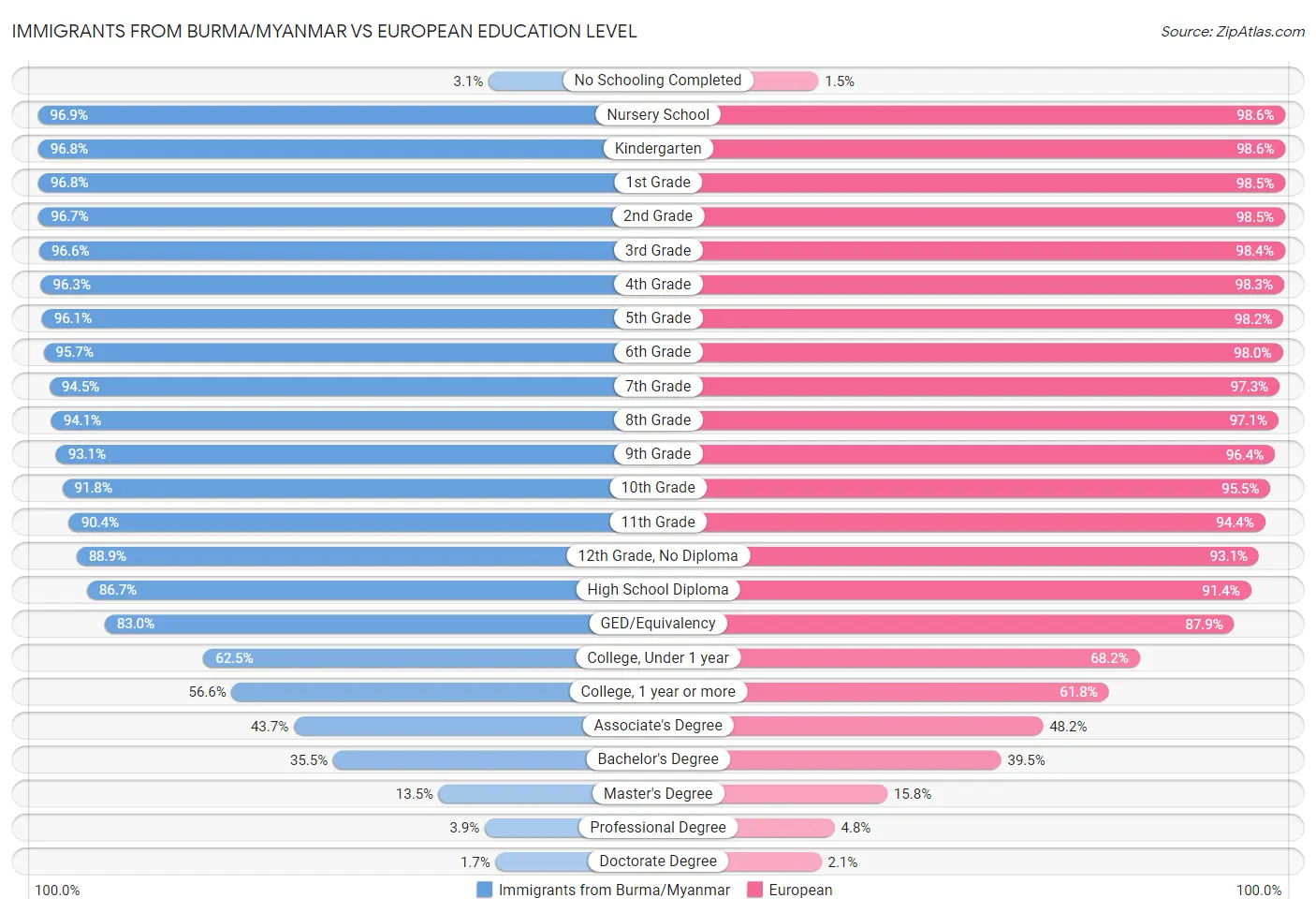
| Education Level Metric | Immigrants from Burma/Myanmar | European |
| No Schooling Completed | Tragic 3.1% | Exceptional 1.5% |
| Nursery School | Tragic 96.9% | Exceptional 98.6% |
| Kindergarten | Tragic 96.8% | Exceptional 98.6% |
| 1st Grade | Tragic 96.8% | Exceptional 98.5% |
| 2nd Grade | Tragic 96.7% | Exceptional 98.5% |
| 3rd Grade | Tragic 96.6% | Exceptional 98.4% |
| 4th Grade | Tragic 96.3% | Exceptional 98.3% |
| 5th Grade | Tragic 96.1% | Exceptional 98.2% |
| 6th Grade | Tragic 95.7% | Exceptional 98.0% |
| 7th Grade | Tragic 94.5% | Exceptional 97.3% |
| 8th Grade | Tragic 94.1% | Exceptional 97.1% |
| 9th Grade | Tragic 93.1% | Exceptional 96.4% |
| 10th Grade | Tragic 91.8% | Exceptional 95.5% |
| 11th Grade | Tragic 90.4% | Exceptional 94.4% |
| 12th Grade, No Diploma | Tragic 88.9% | Exceptional 93.1% |
| High School Diploma | Tragic 86.7% | Exceptional 91.4% |
| GED/Equivalency | Tragic 83.0% | Exceptional 87.9% |
| College, Under 1 year | Tragic 62.5% | Exceptional 68.2% |
| College, 1 year or more | Tragic 56.6% | Exceptional 61.8% |
| Associate's Degree | Tragic 43.7% | Excellent 48.2% |
| Bachelor's Degree | Tragic 35.5% | Excellent 39.5% |
| Master's Degree | Tragic 13.5% | Excellent 15.8% |
| Professional Degree | Tragic 3.9% | Exceptional 4.8% |
| Doctorate Degree | Poor 1.7% | Exceptional 2.1% |
Immigrants from Burma/Myanmar vs European Disability
When considering disability, the most significant differences between Immigrants from Burma/Myanmar and European communities in the United States are seen in disability age under 5 (1.1% compared to 1.5%, a difference of 34.9%), hearing disability (2.9% compared to 3.5%, a difference of 19.6%), and disability age 18 to 34 (6.8% compared to 7.4%, a difference of 8.5%). Conversely, both communities are more comparable in terms of female disability (12.4% compared to 12.4%, a difference of 0.10%), ambulatory disability (6.1% compared to 6.2%, a difference of 0.86%), and vision disability (2.2% compared to 2.2%, a difference of 0.88%).
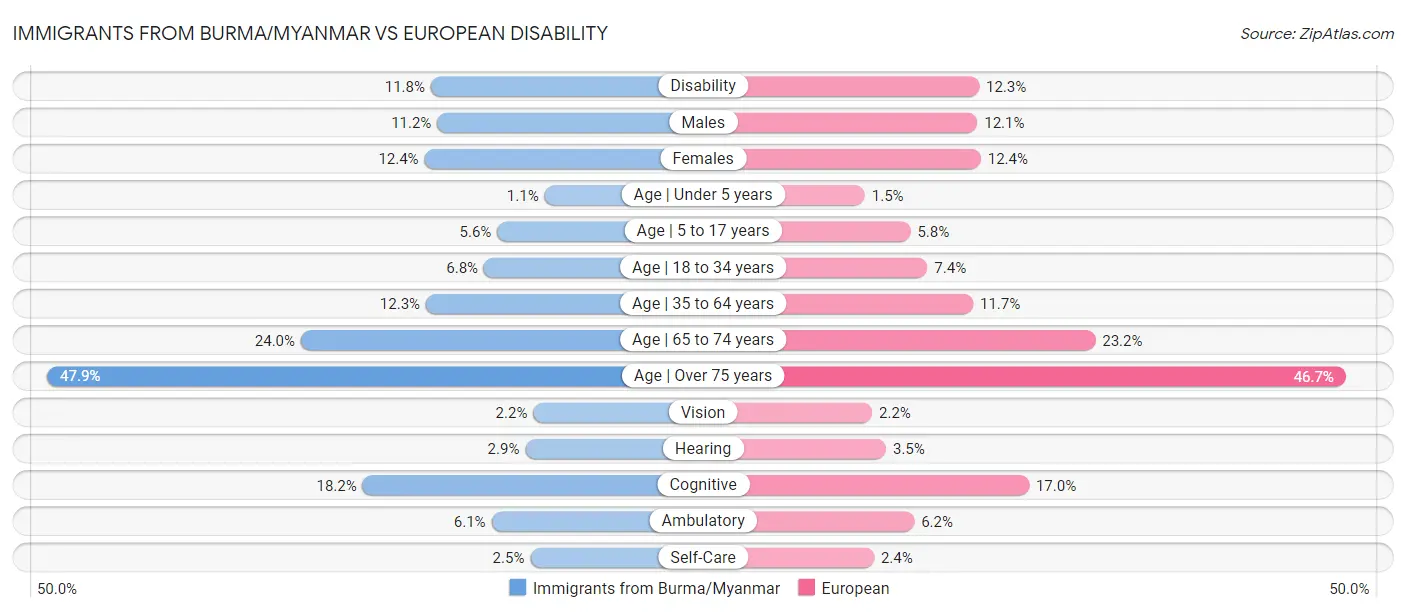
| Disability Metric | Immigrants from Burma/Myanmar | European |
| Disability | Fair 11.8% | Tragic 12.3% |
| Males | Average 11.2% | Tragic 12.1% |
| Females | Poor 12.4% | Poor 12.4% |
| Age | Under 5 years | Exceptional 1.1% | Tragic 1.5% |
| Age | 5 to 17 years | Average 5.6% | Tragic 5.8% |
| Age | 18 to 34 years | Poor 6.8% | Tragic 7.4% |
| Age | 35 to 64 years | Tragic 12.3% | Poor 11.7% |
| Age | 65 to 74 years | Poor 24.0% | Good 23.2% |
| Age | Over 75 years | Poor 47.9% | Exceptional 46.7% |
| Vision | Fair 2.2% | Fair 2.2% |
| Hearing | Good 2.9% | Tragic 3.5% |
| Cognitive | Tragic 18.2% | Exceptional 17.0% |
| Ambulatory | Average 6.1% | Fair 6.2% |
| Self-Care | Average 2.5% | Exceptional 2.4% |